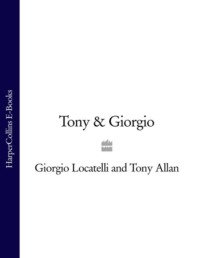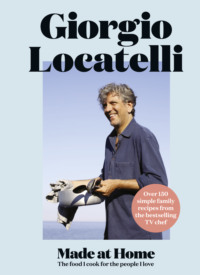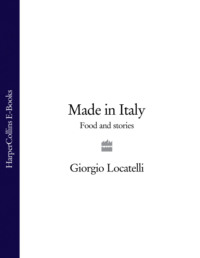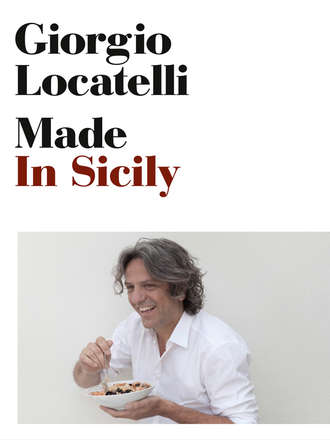
Полная версия
Made in Sicily
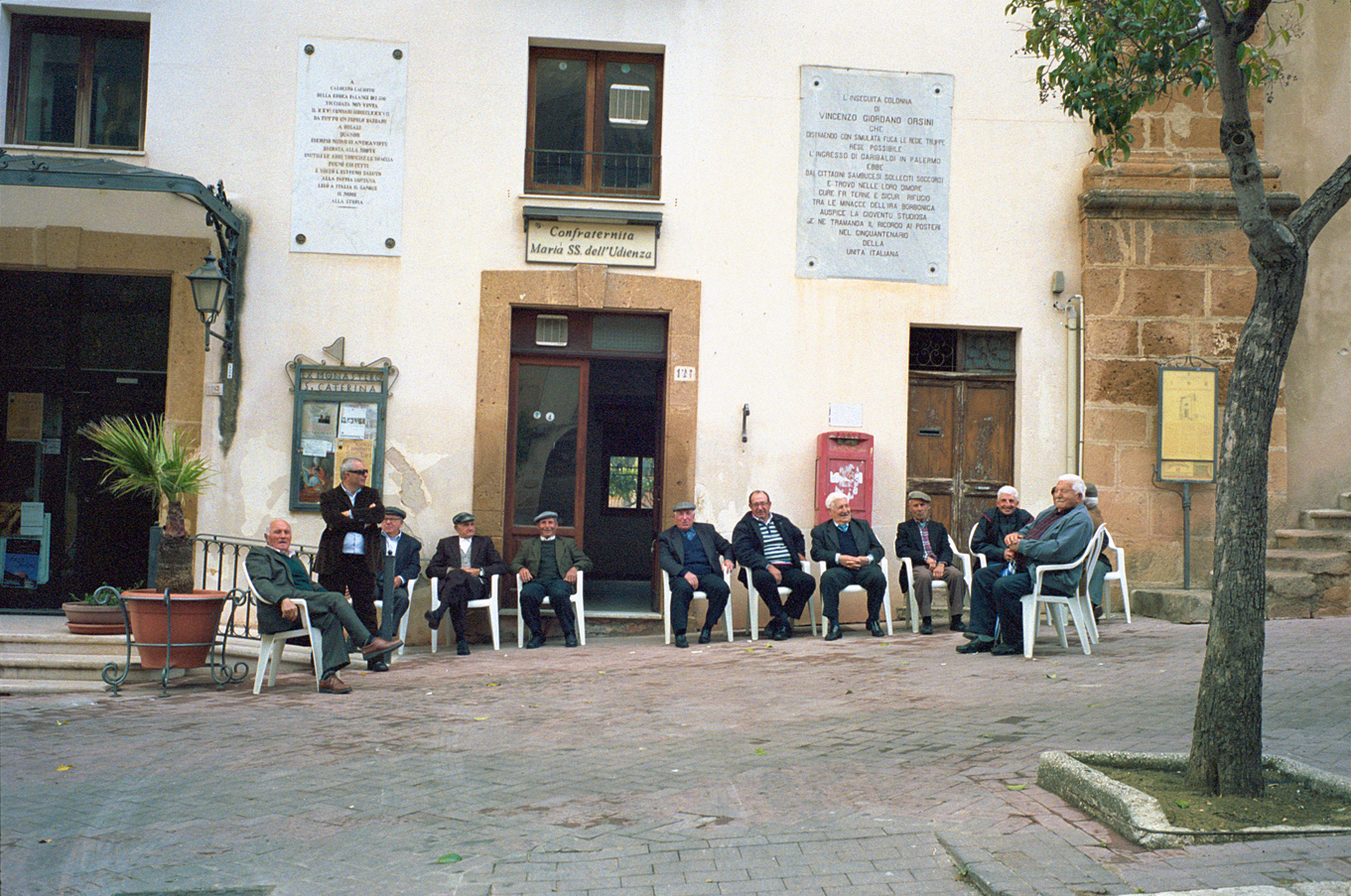
When you go up the mountain you see the fields of lava and the hills it formed when it erupted and fell and hardened like honeycomb, and it is incredible to think that the mountain both kills and nurtures … whole communities have been destroyed by it, but there is nothing that won’t grow in the soil enriched by the volcanic ash.
In Palermo you can see the layers of history in the buildings – churches, synagogues, Arabian mosques – and like most of the world’s cities, you see the extremes of rich and poor, though slowly they are reclaiming the poorer areas. And in the late night eating you see the Spanish and Arab influence. The shops open late, people work until the early evening, go home, relax a bit, then come out for dinner, or eat at home, and then meet friends at a bar or café. I like to sit outside on a hot night at one of the places overlooking the sea, where you can eat pasta con le sarde, or involtini di pesce spada, and ice cream. Always ice cream.
In so many places you see the old ladies preparing food in the way they have done for centuries, with the same ingredients, but there are also some young chefs who are taking the same ingredients and combinations, but interpreting and proposing them slightly differently; not only in Palermo, but in the cities on the other side of the island: Noto, Modica, Messina … In one Michelin-starred restaurant, La Gazza Ladra in Modica, the chef, Accursio Craparo, makes artistic creations such as watermelon salad with sea urchin sorbet; ‘linguine’ with a cream of anchovies, candied orange and wild fennel flowers; and a clever little mini ‘burger’ of beautiful tuna: some of the ventresca (the fat belly) is mixed with some of the back and formed into little ‘buns’ that are part steamed, then fried, and filled with a slice of raw tuna, and a ‘mayonnaise’ of anchovies, lemon, sea urchin and fish liver, with herbs scattered on top.
Palermo is a loud city; from the swallows that wake you up in the morning to the sellers in the market, everyone seems to be shouting. No wonder tourists get scared – and these guys are only trying to sell snails! People say Palermo is dangerous, but I don’t see it as threatening; I find it warm and welcoming. And I like the hustle and bustle and noise. But of course there have been times when, unseen by the outsider’s eye, it has been a dangerous place, because the city is in the heart of Mafia territory.
‘Nobody sees; everybody knows’
If you look hard enough in Palermo, you can still see some of the white stickers that appeared one night all over the city, with a message that translates as: ‘there is no dignity in a people that pays the pizzo’ – the protection money demanded by the Mafia. The stickers were an invitation to join the newly formed addio-pizzo movement, an alliance of restaurants, bars, shops and businesses that display the addio-pizzo sign in their windows, which tells you they are refusing to pay.
You cannot talk about food without talking about the Mafia, because the roots of the Mafia are in the land, and when you control the territory, you can control the production of the food, its transportation, and its price. But food also brings people together, and slowly, slowly, a change is happening in Sicilian society and it is being determined by a young generation of restaurateurs and bar owners and food producers who are finding strength in numbers and the courage to stand up to the might of the Mafia.
In the late 1980s, when I was already cooking in England, the Mafia seemed to be always in the newspapers and on the TV news: the wars between the rival families, the drug trafficking, the money laundering, the murders of anti-Mafia politicians, judges and the investigating magistrates Giovanni Falcone and Paolo Borsellino, the kidnappings, the trials. I was fascinated by it all, but I never seemed to see any explanation as to ‘why?’ For a northern Italian it was difficult to understand the power of the Mafia, the way it had infiltrated every organisation, so much so that during the trials, it was said that the only safe place to talk in the Palace of Justice was in the lift. So for an Anglo-Saxon person, I imagined, it would be almost impossible to understand.
Then I read Cosa Nostra, A History of the Sicilian Mafia, by John Dickie, Professor of Italian Studies at University College London, a brilliant, compelling, but also very scholarly work, which had a very big impact on me. Dickie told the story in a way that had nothing to do with folkloristic Godfather images of ‘Men of Honour’, the kind of glorification that brings busloads of tourists every year to Bar Vitelli in Savoca, near Taormina, where they filmed the wedding festivities of Michael Corleone in Francis Ford Coppola’s movie of the Mario Puzo novel.
Since then I must have devoured a whole library of books on the Mafia, and every time a new one is written, I have to read it. So I have done a lot of searching over the years, to try and understand. You have to think about the history of Sicily: the Greeks and Romans came and left, the Normans came and left, the Spanish came and left, then suddenly Garibaldi arrived and everyone was Italian. But the promises that were made, that the land would be redistributed, didn’t happen. Instead the balance of economic power shifted to the north of Italy, where industry and production increased, and in the south and in Sicily many people just became more poor. So in the vacuum between rich and poor, the state and the people, rose the Mafia.
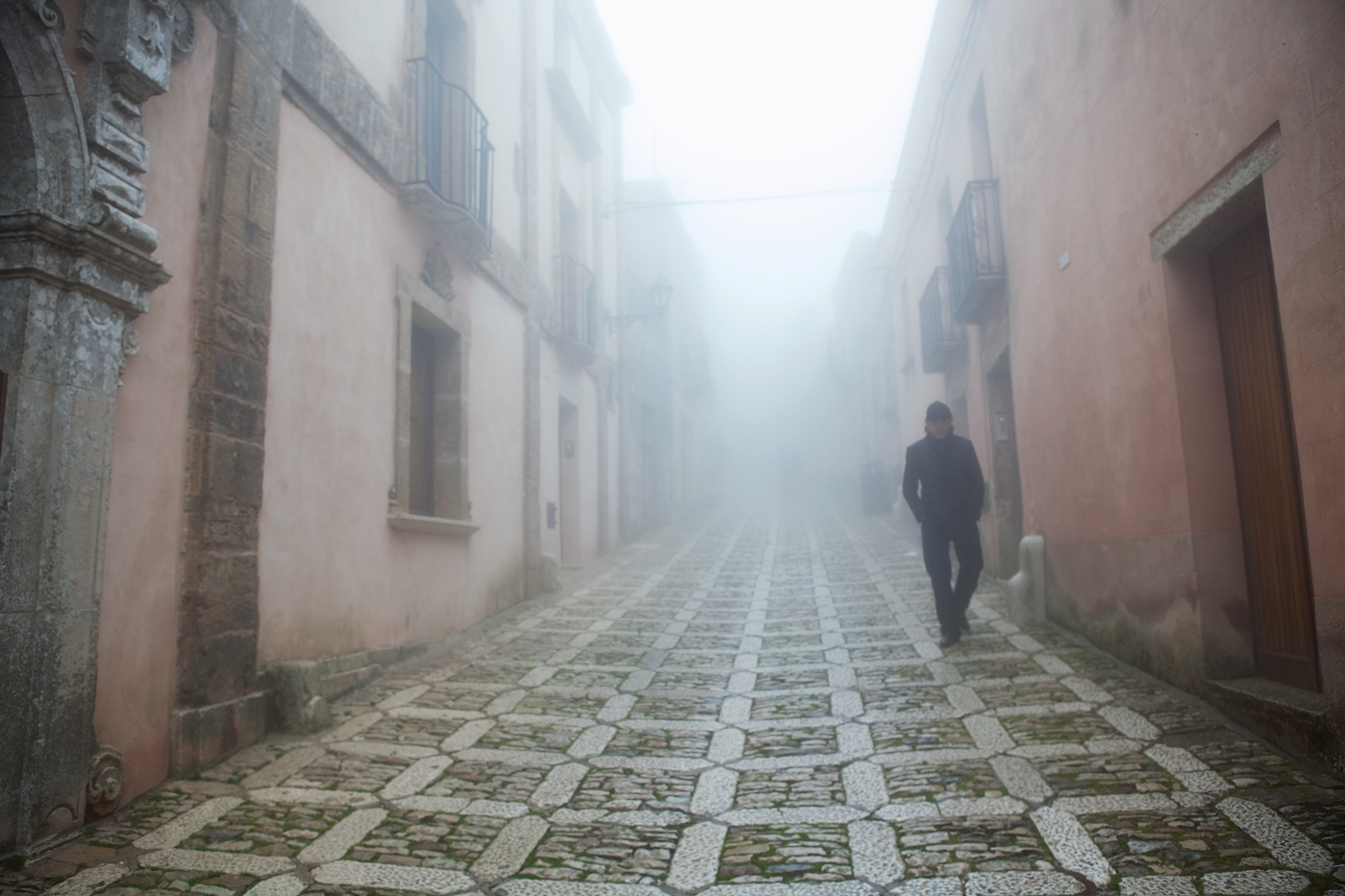
The roots were already there in agriculture under Spanish rule, because the barons who owned the big estates were away in Palermo and in their absence they appointed managers, middle men known as gabelotti, who took a foothold of power, and whose ruthless henchmen were known as campieri. Out of this grew the Mafia, tapping into the Sicilian idea of Cosa Nostra, the sense of family, of looking after one another, all bound up with a sense of fate, maybe inherited from the Greeks, that somehow made the people trust in the Mafiosi, because they were their own, even though they ruled by fear and brutality.
What is interesting is that in the east side of the island the Mafia didn’t take hold in the same way, because there, under the Spanish, the land was allowed to be inherited by a son, and so there were small tenements, rather than baronial estates, and not the same need for the powerful ‘middle men’.
It is only when you spend time in the western side of the island, and get to know the people and the way the place is run, that you can begin to understand that the Mafia is everywhere, but there is no way you can tell who is the Mafia. It is an undercurrent. It is there, and it is not there. Nobody sees; everybody knows. The prices are controlled, and the territory is controlled, centimetre by centimetre.
For a long time, the existence of the Mafia as a structured organisation was denied, right up to the trials of the eighties. Even now there are people who will say it doesn’t exist or, ‘They are good people. They make things work.’ Yes. But it has been proven that the mafia is bad for business, because its presence has slowed down the development of Sicily in comparison to other regions of Italy.
What I feel is that Cosa Nostra is inside the people; you cannot defeat it on the streets, or in the courts of justice alone; you have to do it in heads and minds. In Midnight in Sicily, Peter Robb quotes the writer Leonardo Sciascia, who summed up perfectly the complicated relationship that exists between the community and the Mafia: ‘Take this Sicilian reality I live in: a lot of things that make it up I disapprove of and condemn, but I see them with pain and from inside … It hurts when I denounce the mafia because a residue of mafia feeling stays alive in me, as it does in any Sicilian. So struggling against the mafia I struggle against myself. It’s like a split, a laceration.’
I see some pessimism, but a lot of optimism. Pessimism because not everyone believes in change, and because some say that when the Mafia appears quiet it is at its most dangerous; and optimism in a new-found strength and pride among restaurateurs and food producers, boosted by organisations like Slow Food, which is helping the people to understand that there is a different way to market their food. And then you see the Libera Terra farming projects, in which land confiscated from convicted Mafia bosses is being given to co-operatives of young people to grow crops or make wine. The most famous is the Terre di Corleone, where a vineyard has been planted on the land of the imprisoned Salvatore ‘Toto’ Riina, near the town whose name Mario Puzo borrowed for his family in The Godfather. Ironically, he chose it just because he liked the sound of the name (which means Lionheart), with no idea of how notorious Corleone was to become as a Mafia town a decade later. When you see these agricultural projects, you have real hope that at last the people will begin to accept that they can work this beautiful land for themselves, and come out from under the cloud of Cosa Nostra.
Verdure
Vegetables
Insalata di olive verdi schiacciate
Menta
Panelle di ceci
Finocchietto selvatico
Panelle di fave
Maccheroni nel ‘maccu’ fritto
Carciofi
Carciofi ripieni
Frittedda
Stufato di verdure primavera
Insalata di rinforzo
Insalata di broccoli, mandorle e peperoncino
Insalata d’acciughe, fagiolini e mandorle
Insalata di fagioli verdi
Insalata d’estate
Insalata di Natale
Asparagi selvatici in umido
Cardi fritti
Caponata
Caponata d’estate
Caponata d’inverno
Caponata di carciofi
Caponata di Natale
Melanzane
Melanzane a beccafico
Involtini di melanzane
Parmigiana di melanzane
Zucchine fritte
Peperoni in agrodolce
Peperoni ripieni
Peperoni con aglio e basilico
Cicoria e aglio
Polpettine di cavolfiore
Torta di bietole e ricotta
Olives and oil
Olives in the mountains
Liquid gold
Sicilian Samurais
Olives for the table
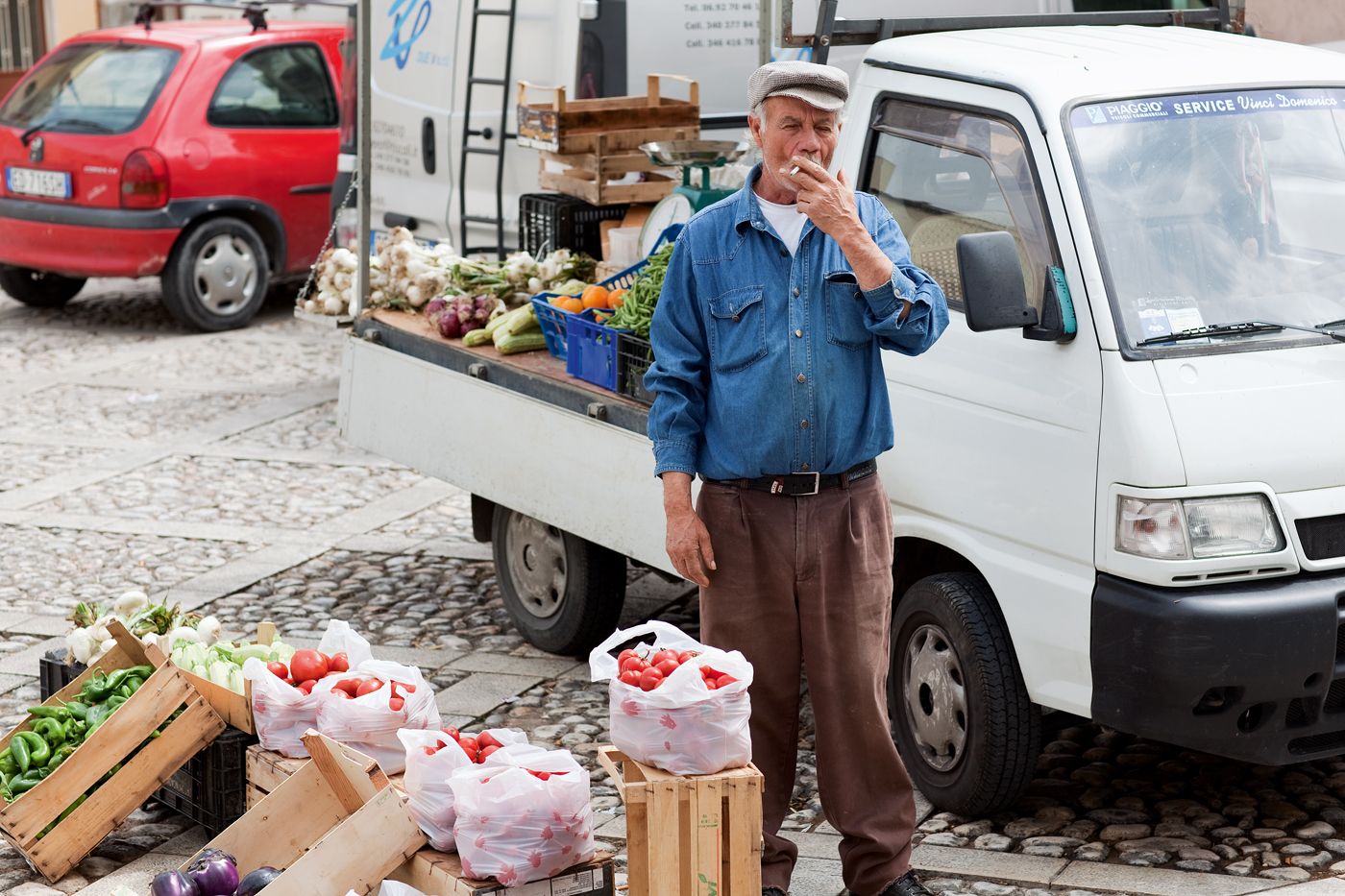
‘What did you eat?’
Then he understood. Livia was trying to be there with him, at his house in Marinella. She was imagining him the way she had seen him so many times before, trying to annul the distance by picturing him as he performed the customary acts he did every evening. He suddenly felt overwhelmed by a feeling that was a mixture of melancholy, tenderness, regret and desire.
‘Caponata,’ he said in a choked-up voice.
How on earth was it possible to get a lump in one’s throat simply by uttering the word ‘caponata’?
– Andrea Camilleri, The Wings of the Sphinx, an Inspector Montalbano mystery
The first time we stayed in Sicily on holiday I got up early one morning and walked to the square, where I found all these old guys with their little three-wheeler Ape Piaggio trucks parked up. In the back were boxes of tomatoes, aubergines, artichokes and all kinds of other vegetables. The way things work is that if a local family has a small piece of land, the men get up at about five in the morning, pick their produce, then pack it into boxes and drive to the square. Then at about 7.30 a.m. a bigger truck comes along from the greengrocer’s in town and the driver buys one box from this guy, two from the next … and that is how the local people make a living.
Later in the day, you see these same guys driving around the village with more vegetables in the back of their Apes, tooting their horns, so you can come out of your house and buy them in your street. Sometimes when I drop in on my friend Vittorio, in his restaurant kitchen in Porto Palo, he will say to me: ‘Drive towards Menfi, and just before you get to the village, on the corner of the last road on the right, you will see a box of tomatoes.’ He will have called someone he knows and said, ‘I need more tomatoes,’ and the guy will have said, ‘OK, I’ll leave them on the corner of the road for you.’ Such a funny, fantastic way to run a restaurant.
But what it shows you is the freshness of the ingredients, always. That’s what strikes me every time I go to Sicily. Even if you don’t grow your own vegetables, every day you can buy ones that have been harvested by someone else in your village that morning – each vegetable seems to have many different seasons, which keeps them going almost all year round. And the flavour! You can see why Sicilians don’t elaborate their dishes, when a tomato or even celery delivers so much taste all by itself. I remember picking up a head of celery in the market, to put into a chicken stock, and the guy selling it said, ‘No, have this one, it is much better’ – and gave me a very woody-looking one instead. Back at the house I put about two stalks into the pot, as I would usually, and the stock turned out to taste only of celery – that aniseed flavour you get from celery, which is usually quite subtle, was huge – so sometimes you have to balance what you do, because of the unexpected strength and richness of flavour in the vegetables.
What I see everywhere is a great love of greens: so many recipes with broccoli, especially with anchovies and pasta, but the broccoli is different. Known as sparaceddi or sparacelli, it is bigger, quite leafy, with greeny-gold heads, the colour of the sprouting broccoli we see in the UK when it flowers, and with a sweeter, less grassy flavour.
Also, they have something I never saw in Italy before: tenerumi, which is the curly tendrils, stalks and leaves of the zucca trombetta, or trumpet pumpkin. This is a long, curvy, pale green kind of cross between a courgette and a squash or pumpkin that is hard on the outside and soft inside, with seeds. It is one of the squashes that is often candied and used to decorate cassata and other desserts.
The first time I saw tenerumi, which tastes of courgette, but is somehow ‘greener’, I was embarrassed that I didn’t know what it was. Fortunately the guys in the market didn’t know I was a chef when I asked them what to do with it! They told me blanch it briefly, then heat some olive oil in a pan, add some garlic, chilli and chopped tomatoes, put in the tenerumi, let it wilt like spinach and serve it with pasta, and it was so good. Traditionally, tenerumi was also just boiled and then some broken-up bits of spaghetti were added to the pan, along with some sautéed garlic and tomato – so the dish ended up more like a brodo (soup). Or it was put into a fish soup, with clams, calamari and mussels.
This simple way of blanching and then sautéing is used for every kind of greens, such as chard (which are smaller and less aggressive in flavour than the ones we get in the UK), cardoons and chicory – not spinach so much, because it is too fragile. They prefer the sturdier greens with stalks, which can be chopped up and blanched first, followed by the leaves. When the drained leaves are quickly tossed in oil, garlic and chilli, they can be put out as antipasti, cold or hot, or eaten with fish or meat. If the greens are to be eaten with pasta, when they are lifted from their boiling water to drain, the pasta goes straight into the same cooking water, so that it takes on some of the colour and flavour of the greens. When the pasta is drained it is just mixed with the sautéed greens, and the flavour of the vegetables is so intense you don’t need anything else.
The Sicilian use of cauliflower is amazing, too, especially the purple ‘bastardu’ cauliflower that grows in the volcanic soil below Mount Etna, and has its own sweet, delicate flavour. What do we do in Britain with cauliflower? Cover it with cheese, and that is about it. There, they use it in so many sweet and sour combinations of vegetables, or make a fantastic salad with cauliflower and black olives (Insalata di rinforzo). In the bakers’ shops you can buy schiacciata (Schiacciata con salsiccia), which is a kind of baked pie made with a focaccia-like dough that is rolled out into two rectangles, one thicker than the other. The thicker one is covered with pieces of cauliflower, together with the likes of sausage meat or anchovies, raisins, olives, caciocavallo or pecorino cheese, oregano, and sometimes tomatoes. Then the thinner rectangle is put on top, pressed down to seal, and the whole thing is baked, then cut up into pieces.
The other vegetable that is synonymous with Sicily is the aubergine (Melanzane). One of the most famous dishes is pasta alla Norma, that brilliant, vivid combination of aubergine, tomato and salted ricotta (Reginette alla Norma), and most of the aubergine dishes are variations on similar combinations of ingredients. In one restaurant I ate a beautiful dish of pan-fried aubergine, which was rolled up around a filling of ricotta, marjoram, ricotta salata (which is the hard, aged, and quite salty ricotta that can be grated), then covered in tomato sauce, topped with caciocavallo cheese, and baked. In another place they served something similar, but the slices of aubergine were layered on a big plate, with tomato sauce, basil and ricotta salata, then cut up in slices, and you ate them just as they were, cold, as an antipasto.
Equally famous outside of Sicily is caponata (Caponata), the mix of fried aubergine and other vegetables in a sweet and sour sauce, made with vinegar and sugar, that owes much to the Arabs, who introduced the growing of sugar cane to the island. Until then honey was the only sweetener. As always, you would make caponata with whatever vegetables you had, and there are so many different recipes, four of which I have included in this chapter.
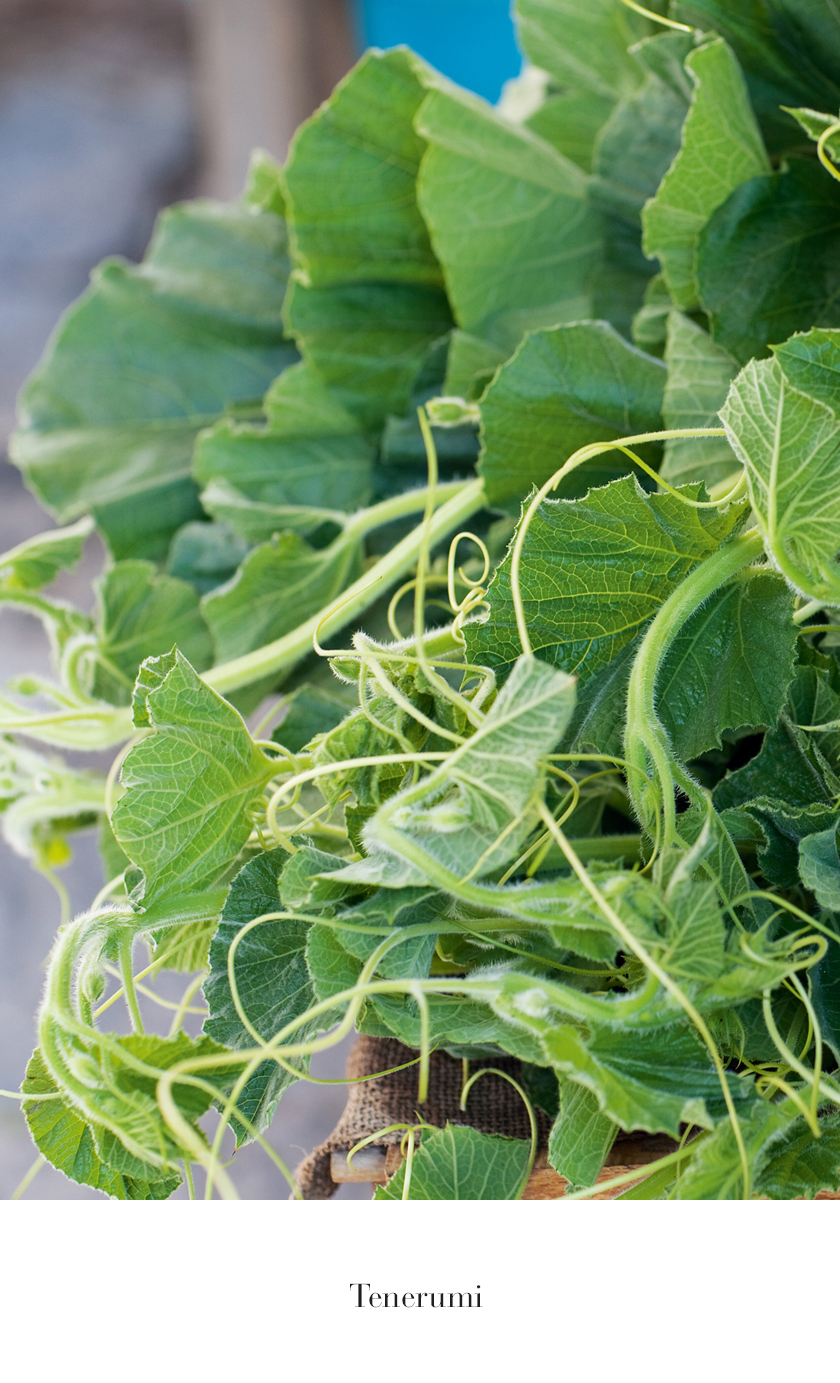
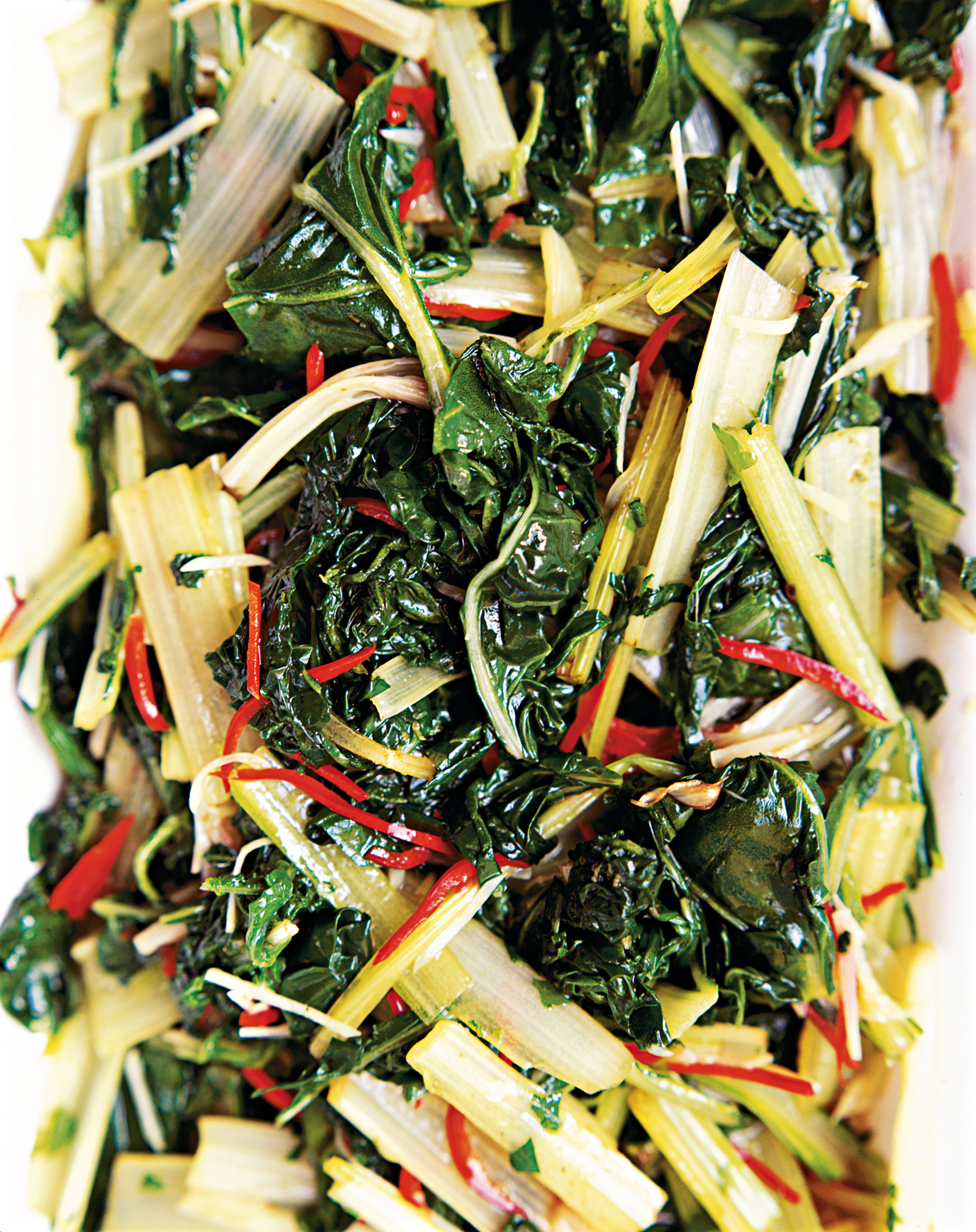
When you look at old books on Sicilian food, no mention is made of what a recipe would be served with; there is just a feeling that you would make it and put it on the table with whatever else you had, so all of these vegetable dishes would make a great addition to the antipasti, but they would also be brilliant with grilled fish or meat.
Although the dishes in this chapter are predominantly made with vegetables, this is the food of Sicily, so it is inevitable that anchovies manage to find their way into many of the recipes!
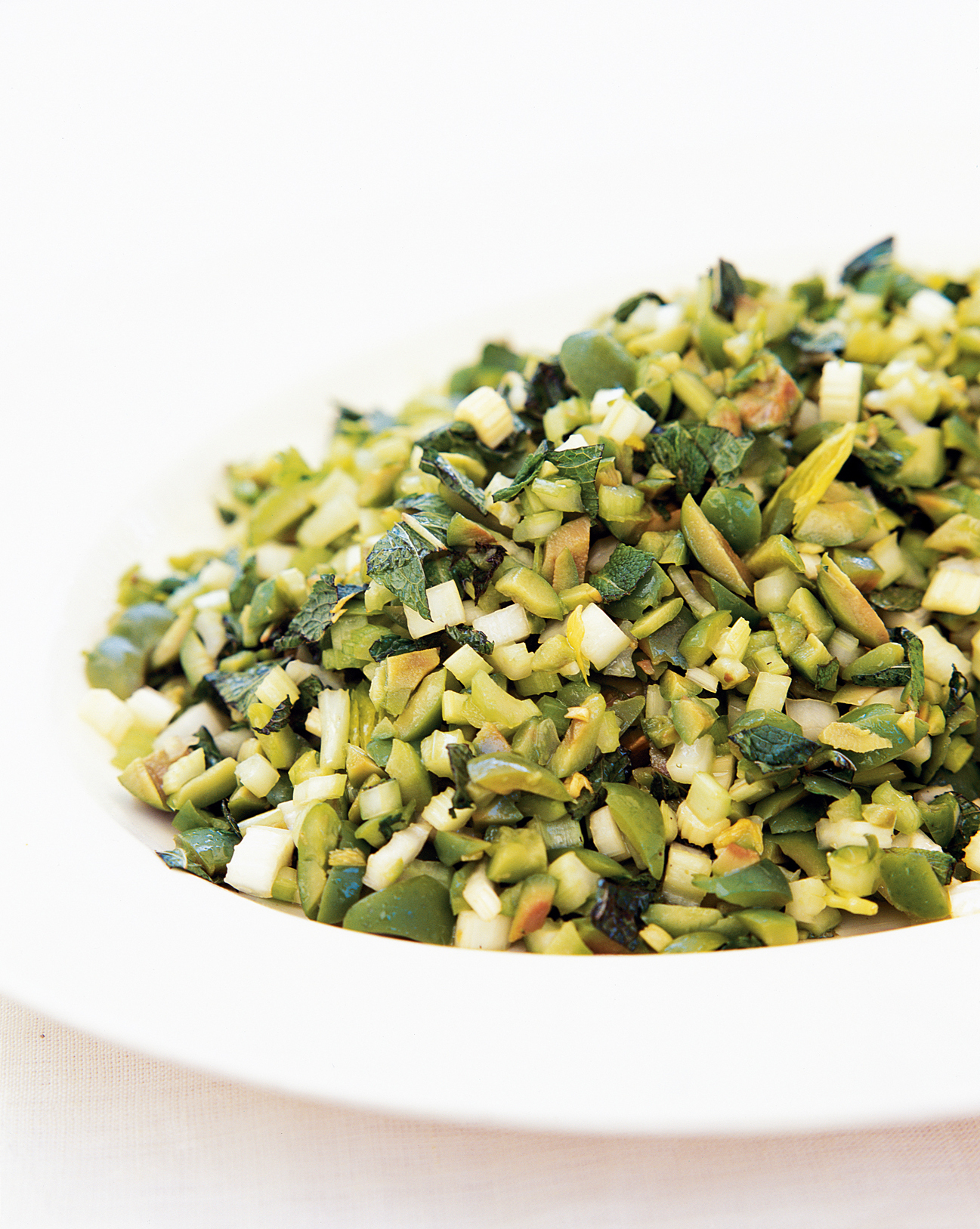
Insalata di olive verdi schiacciate
Salad of crushed olives
When you look at the ingredients of this salad, you will probably think, as I did, that it is too simple to be very exciting, but it is unbelievable the way the celery takes up the flavours and combines with the olives and mint, so that the whole thing tastes really fresh and fantastic.
Serves 4–6
450g good whole green olives in brine
about 6 celery stalks, with leaves if possible, all finely chopped
the leaves from about 10–12 stalks of mint, finely chopped
40ml Giorgio’s dressing
sea salt and freshly ground black pepper
Drain the olives and pat dry. With a sharp knife, make three or four cuts in each olive from end to end, then cut each segment away from the stone as carefully as you can. Put the pieces into a bowl and add the celery, the celery leaves, and the mint leaves. Toss with the dressing, season and serve.
Menta Mint
‘A herb that people would love forever’
Mint is a very Sicilian herb, and something you rarely see in other regions of Italy. The story is that Mentha was a Greek nymph who was loved by the god Pluto. His wife, Persephone, was so jealous of Mentha that she crushed her into the ground, but Pluto turned her into a herb that people would love forever.
There is an incredible number of different mint varieties, but the one that is most often found in Sicily is Mentha viridis (spearmint), which grows everywhere. It is one of the herbs that is said to stimulate the appetite, so it is often used in dishes that appear with the antipasti: in an olive salad (Insalata di olive verdi schiacciate), or with fresh peas and artichokes. Coming from the north of Italy, where basil is the beloved herb, I have been surprised and entranced by the way a few leaves of mint can change the whole nature of a simple salad; and whenever I am in Sicily, I also make tea out of it. The important thing to remember with mint, though, is that it must always be freshly picked and used immediately, as it is a herb that loses its flavour the moment it is cut.
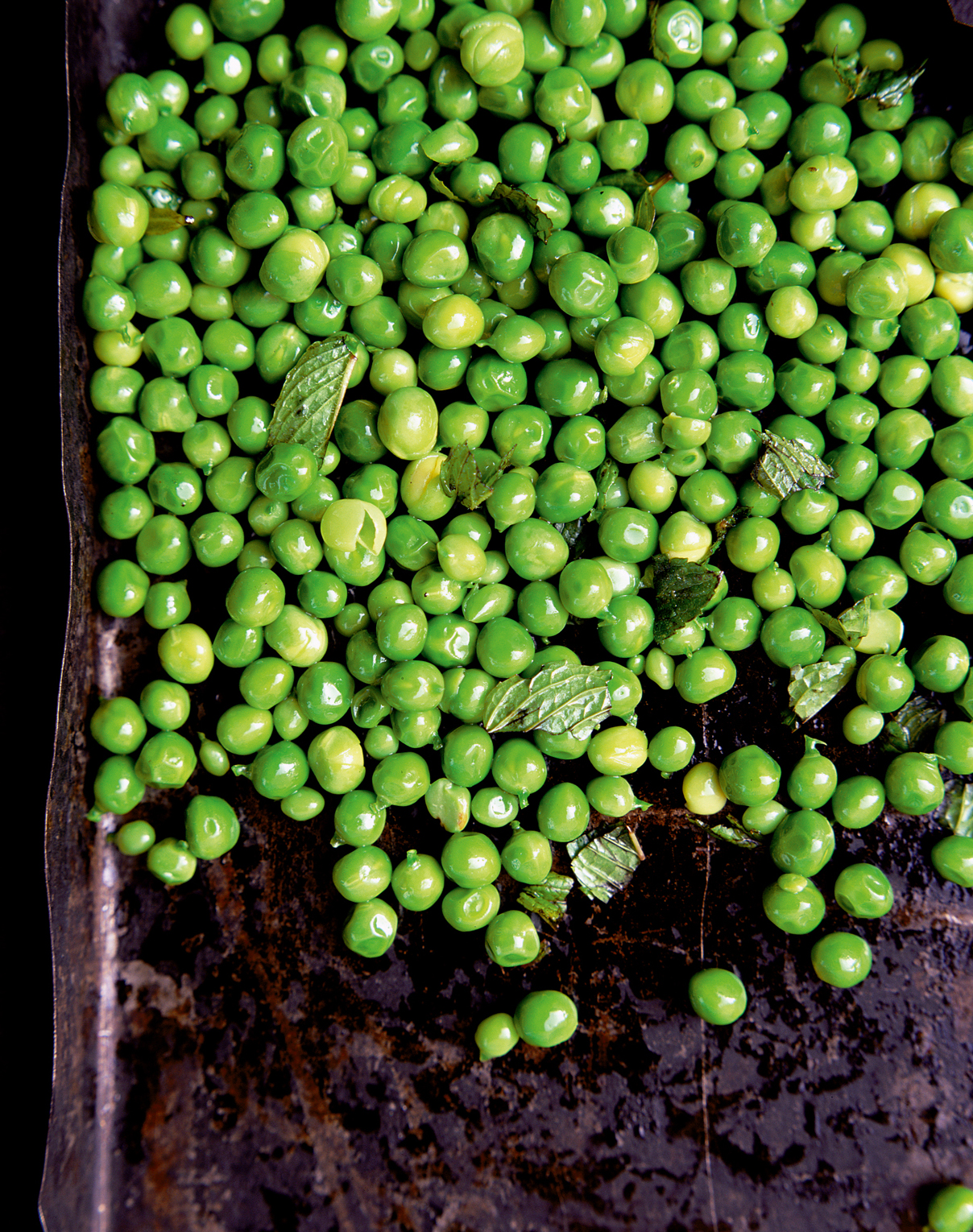
Panelle di ceci
Sicilian chickpea fritters
Panelle is the quintessential street food. In Palermo you see vendors frying the thin fritters of chickpea flour in oil on street corners, or in the Vucciria market, and in the smaller towns and villages you see guys driving around in their little three-wheeled Ape Piaggios, with a gas burner on the back. They stop where they feel like it, fire up the burner underneath a big wok-like pot of olive oil, and start frying.
Serves 4
250g chickpea flour
a pinch of salt
a handful of flat-leaf parsley leaves, finely chopped
a little olive oil
vegetable oil for deep-frying
sea salt
Pour 500ml of cold water into a heavy pan, then add the chickpea flour in a steady stream, whisking constantly to avoid lumps.
Add the salt and cook over a medium heat, stirring constantly with a wooden spoon, until the mixture thickens and pulls away from the sides of the pan. Add the parsley.
Rub a cold surface (marble if possible) with olive oil, spoon out the mixture, and spread it out thinly (about 3mm) with a rolling pin or spatula. When it cools down, cut it into squares or triangles.
Heat the vegetable oil in a deep pan, making sure it comes no higher than a third of the way up the pan. It should be 180°C. If you don’t have a thermometer, put in a few breadcrumbs, and if they sizzle straight away the oil is ready. Deep-fry the fritters until golden, about 1–2 minutes. Drain on kitchen paper, sprinkle with sea salt and serve warm.
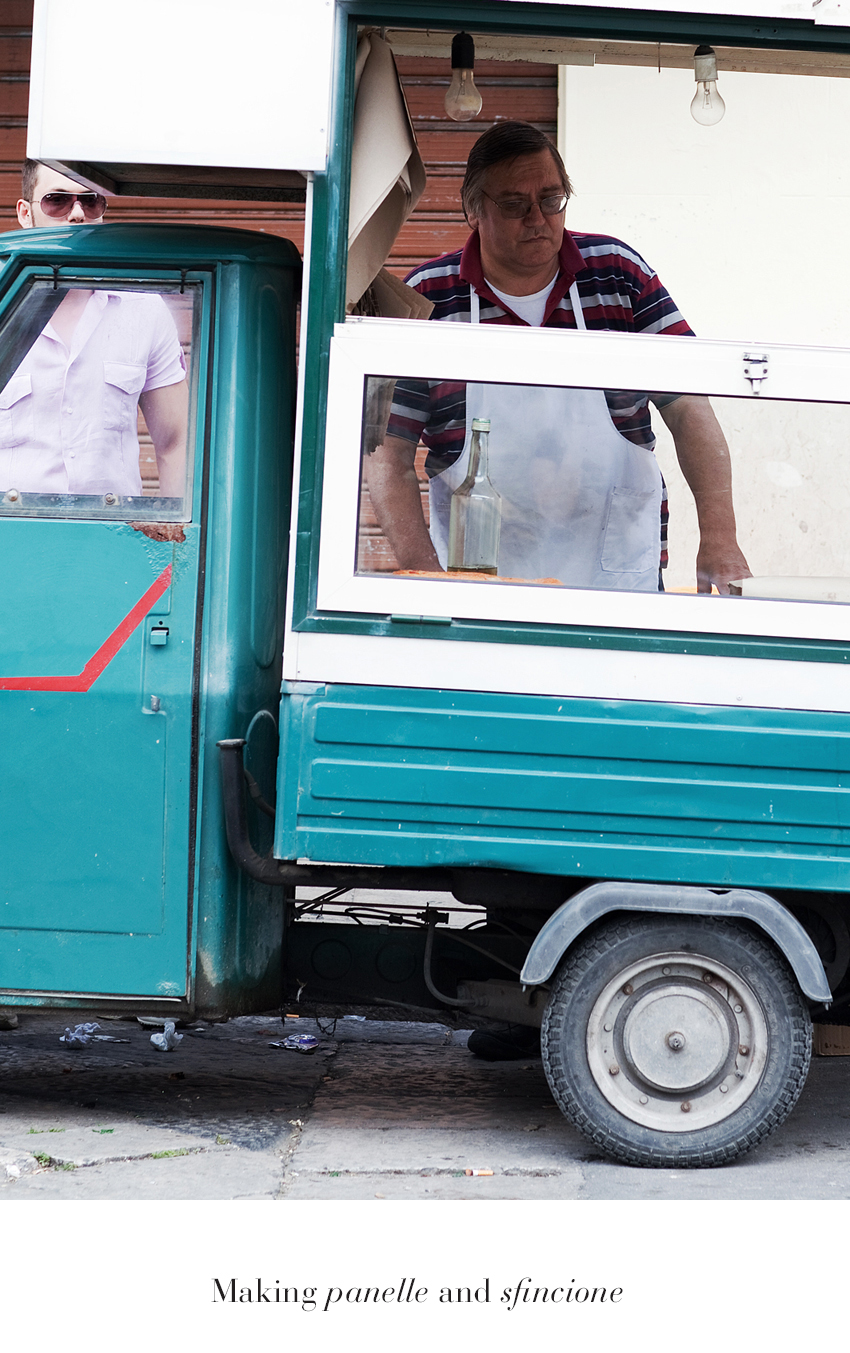
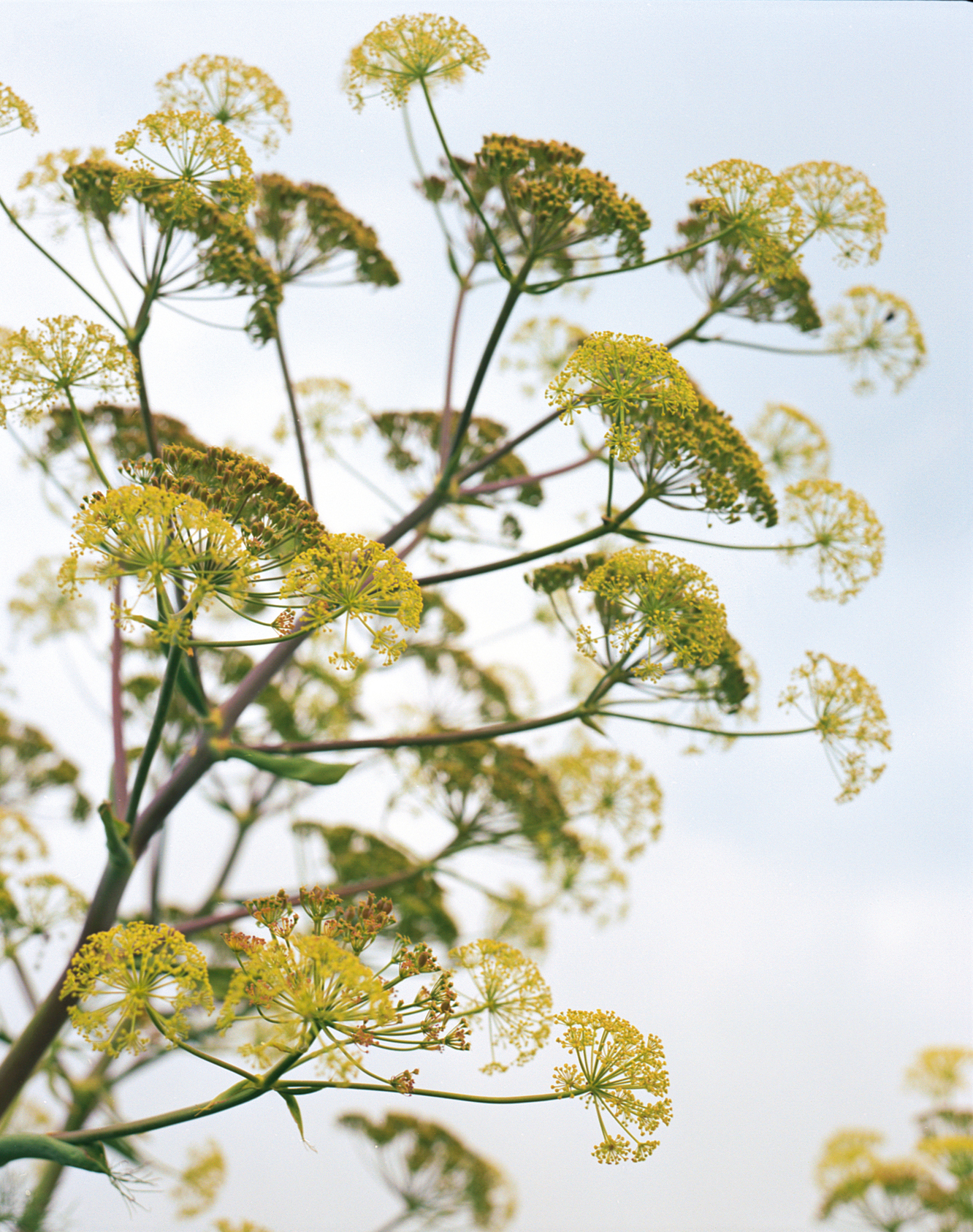
Finocchietto selvatico Wild fennel
‘A flavour that feels only Sicilian’
If I had to identify a flavour that feels only Sicilian, then it is wild fennel. If basil represents the north of Italy, then wild fennel represents Sicily.
There are three types of fennel: the bulb, or Florence fennel, that Sicilians use in caponata and raw in salads; then there is the sativa, which is the intensely flavoured one that makes the seeds that Americans put in everything Italian. You go to America and you have to say, ‘Can I have something to eat that is without fennel seeds, because not all Italian food has fennel seeds in it!’ In Sicily the seeds are used in some sauces and breads. But mostly, they use wild fennel, because it grows everywhere.


